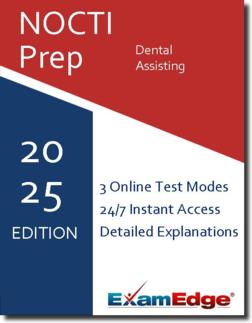NOCTI Dental Assisting Practice Tests & Test Prep by Exam Edge - Additional Information
Based on 34 Reviews
- Real Exam Simulation: Timed questions and matching content build comfort for your NOCTI Dental Assisting test day.
- Instant, 24/7 Access: Web-based NOCTI Dental Assisting practice exams with no software needed.
- Clear Explanations: Step-by-step answers and explanations for your NOCTI exam to strengthen understanding.
- Boosted Confidence: Reduces anxiety and improves test-taking skills to ace your NOCTI Dental Assisting .

NOCTI Dental Assisting - Additional Information
What is on the NOCTI Dental Assisting Exam: Detailed Breakdown.
The NOCTI Dental Assisting exam covers seven main content areas: introduction to the professional, communication skills, infection control and hazard management, clinical procedures, radiological and digital imaging, clerical functions, and dental sciences.
These domains are addressed throughout the 199 questions that the NOCTI Dental Assisting test comprises. Clinical procedures alone make up nearly 40 percent of the test questions, so you'll definitely want to spend extra time reviewing them before exam day. A NOCTI Dental Assisting practice test can help you understand which content areas you've mastered and which warrant further study.
How is the NOCTI Dental Assisting Test Scored?
The National Occupational Competency Testing Institute is the group responsible for both creating and scoring the NOCTI Dental Assisting exam. After you complete your test, it will be scored and interpreted by NOCTI officials, who will then develop an Individual Score Report. If you answer at least 70 percent of questions correctly, you'll pass the NOCTI Dental Assisting test.
Approximately eight percent of the test centers around the dental profession. Six percent of the exam covers communications skills. Another 11 percent of the exam focuses on infection control and hazard management. 39 percent of the test is on clinical procedures. Radiological and digital imaging procedures make up another 16 percent, while clerical functions cover around 9 percent of the test. Dental sciences make up the final 11 percent of the test.
NOCTI Dental Assisting practice questions can help you familiarize yourself with this content ahead of the real test. A practice test can give you much-needed insight into how you might perform if the exam were happening today. You'll also get the opportunity to see which content areas warrant further study and which you've already mastered. Research proves it: practice tests are some of the most effective study aids available.
What to Expect After the Test.
After finishing your NOCTI Dental Assisting exam, you may have to wait several weeks for your results. Patience is a must! If you discover you didn't earn the score you'd hoped for, it's possible to sign up for a retake. Of course, retakes can be expensive and time-consuming. If you're hoping to earn a passing score on your very first attempt, be sure to incorporate NOCTI Dental Assisting practice questions into your study schedule.
There are a lot of misconceptions about dental assisting and the certification process necessary for such a career. If you're serious about pursuing this line of work, spend some time understanding what's expected of you both on test day and beyond. Your future self will thank you for putting in the work!


